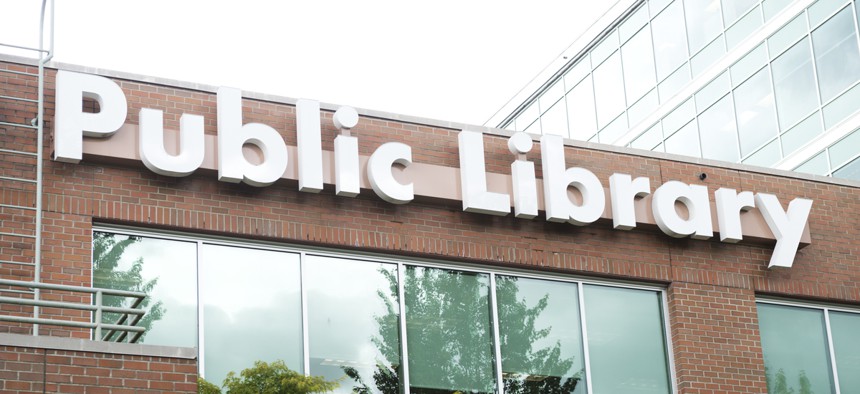Americans Go to the Library More Than Anywhere Else

Americans went to the library an average of 10.5 times per year in 2019 Shutterstock
New survey data found that library visits outstripped all other activities measured, including going to the movies or museums.
Americans went to the library an average of 10.5 times in 2019, beating out trips to movie theaters, sporting events, national parks, museums and zoos.
According to a new Gallup poll, libraries were almost twice as popular as movie theaters and ten times as popular as zoos. The high rate of library visits is driven largely by women, who averaged 13.4 visits in 2019, compared to men’s 7.5 visits. While men still preferred libraries, they were more likely than women to go to casinos, sporting events and national parks.
Jill Hurst-Wahl, who leads the Public Libraries Initiative at Syracuse University, said that the usage data isn’t unexpected.
“The data doesn’t surprise me, but it surprises other people,” she said. “Most people see their local public library, which they do or don’t use. Usage data surprises people because there has been this ongoing idea that you can find what you need on the internet somewhere and that you don’t need a library anymore.”
The Gallup poll noted that libraries may be popular as public spaces because they provide more than just books. These days, most libraries offer services like free Wi-Fi, movie rentals, and children’s activities. “Despite the proliferation of digital-based activities over the past two decades—including digital books, podcasts, streaming entertainment services and advanced gaming—libraries have endured,” the report reads.
About two-thirds of people who visit libraries borrow print books, and about half use the space to read and work or use media materials.
The poll also found that higher income households were more likely to engage in almost every activity except visiting the library. For activities like attending sporting events, visiting museums or attending concerts, frequent participants were more likely to make more money.
Conversely, households making $40,000 or less were the most likely to use the library, with an average of 12.2 visits, compared to 8.5 visits for households making more than $100,000.
Library use over time has fluctuated, said Patrick Sweeney, the political director for EveryLibrary, a nonprofit that helps organize public support for library funding. During the Great Recession, library use ballooned, especially among people using the internet to search for work. But funding to libraries was cut at the same time, and usage rates plateaued. “Years later, libraries are just now starting to regain their footing,” Sweeney said. “So, we’ll likely see visit rates continue to increase.”
Several cities have made efforts in recent months to draw more low-income patrons to their local library branches by eliminating late fees entirely and wiping the debt of residents whose cards had been frozen. In the past year, cities like Chicago and St. Paul, Minnesota, have done away with fees and seen striking results. Chicago saw a 240% increase in the return rate of materials within three weeks, while St. Paul saw double digit increases in circulation at its branches in the city’s poorest neighborhoods.
Monique le Conge Ziesenhenne, the past president of the Public Library Association, said that the push to be welcoming to low-income residents is part of the history of public libraries in America. “During the Great Depression, many men would go to the public library and read to improve themselves while they were out of work,” she said. “Libraries are meant to be public spaces that are open to anyone. I think that it resonates for people because they understand that the library is a place where they’re not going to be watched or judged or feel like the other.”
Ziesenhenne said that for the past two decades, libraries have made a concerted effort to assess community equity needs and find ways to respond. “Libraries have always held a unique place in the social fabric of community,” she said. “And the data on millennials confirms that isn’t going away.”
The Gallup poll, which was conducted in December 2019 and surveyed 1,025 adults, found that people aged 18 to 29 were most likely to visit the library, following similar research in recent years. A 2017 study from Pew Research Center found that millennials were frequent users of libraries, even when university libraries were removed from consideration.
Pew researchers surmised that high library use among millennials might be related to efforts made by public libraries to curate “expensive and scarce” resources like maker spaces and recording studios. “Previous Pew Research Center surveys have documented how extensively people use computers and internet connections at libraries, as well as how interested they are in extra services such as literacy programs for young children, meeting spaces for community groups, and technology “petting zoos” that provide opportunities to explore 3D printers and other tech gadgetry,” researchers noted.
Sweeney said that libraries look different in each community, but that one of the biggest misconceptions is that they only have books. “They’ve branded themselves around books because that was where information was held. Now it’s held on a wide variety of media,” he said. “In Sunnyvale [California], the library has a business center, so you could have an idea, 3D print it, patent it, and then use the library databases for market research.”
Hurst-Wahl said that her local library in Onondaga County, New York, circulates technology backpacks with laptops and WiFi hotspots so that people without internet access at home have a way to do homework, search for jobs, and connect with family—but she wouldn’t call any of these new features a renaissance for libraries. “Things we take for granted often start at libraries. There was a point when online databases were only available at libraries to most people,” she said. “Libraries have always added new features. What’s new is that people are noticing.”
Emma Coleman is the assistant editor for Route Fifty.
NEXT STORY: American Law Does Not Take Rape Seriously






